Individual Macroeconomics Assignment: ECO2103 CA1 Analysis
VerifiedAdded on 2022/11/15
|10
|1843
|244
Homework Assignment
AI Summary
This macroeconomics assignment analyzes five articles from various news sources, each focusing on a different macroeconomic aspect. The first article examines India's economic slowdown, attributing it to decreased consumer demand and investment, and discusses potential expansionary monetary policy by the Reserve Bank of India. The second article focuses on the UK's inflation rate, wage growth, and the impact of Brexit. The third article discusses the UK's high wage rate and low unemployment rate, with a focus on the impact of Brexit. The fourth article examines the Indian economy's need for increased savings and capital formation to boost economic growth. The final article discusses the Indian government's reduction in expenditure to meet its fiscal deficit target. Each section provides a summary of the article, followed by an analysis using macroeconomic concepts and diagrams to illustrate key points.
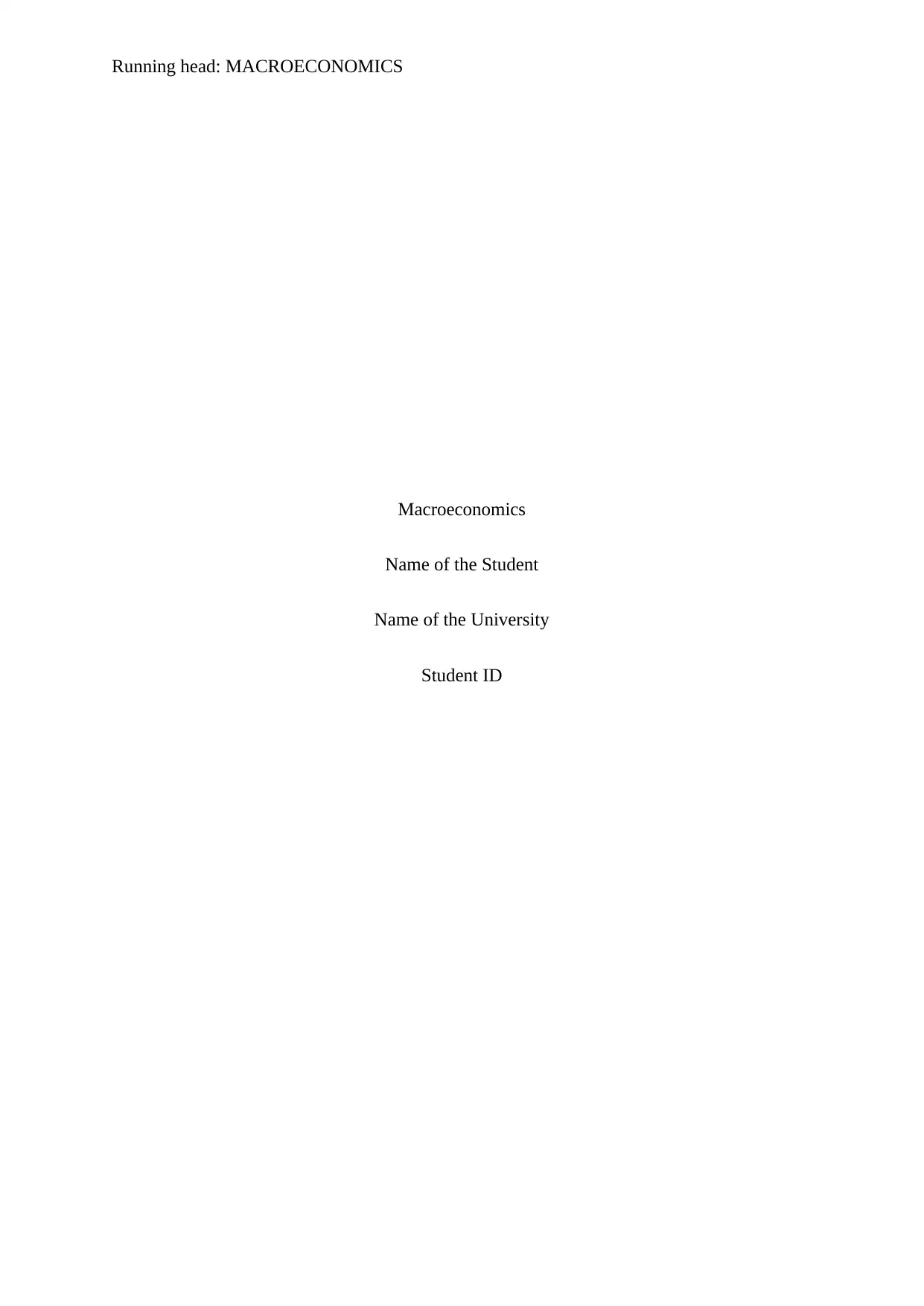
Running head: MACROECONOMICS
Macroeconomics
Name of the Student
Name of the University
Student ID
Macroeconomics
Name of the Student
Name of the University
Student ID
Paraphrase This Document
Need a fresh take? Get an instant paraphrase of this document with our AI Paraphraser
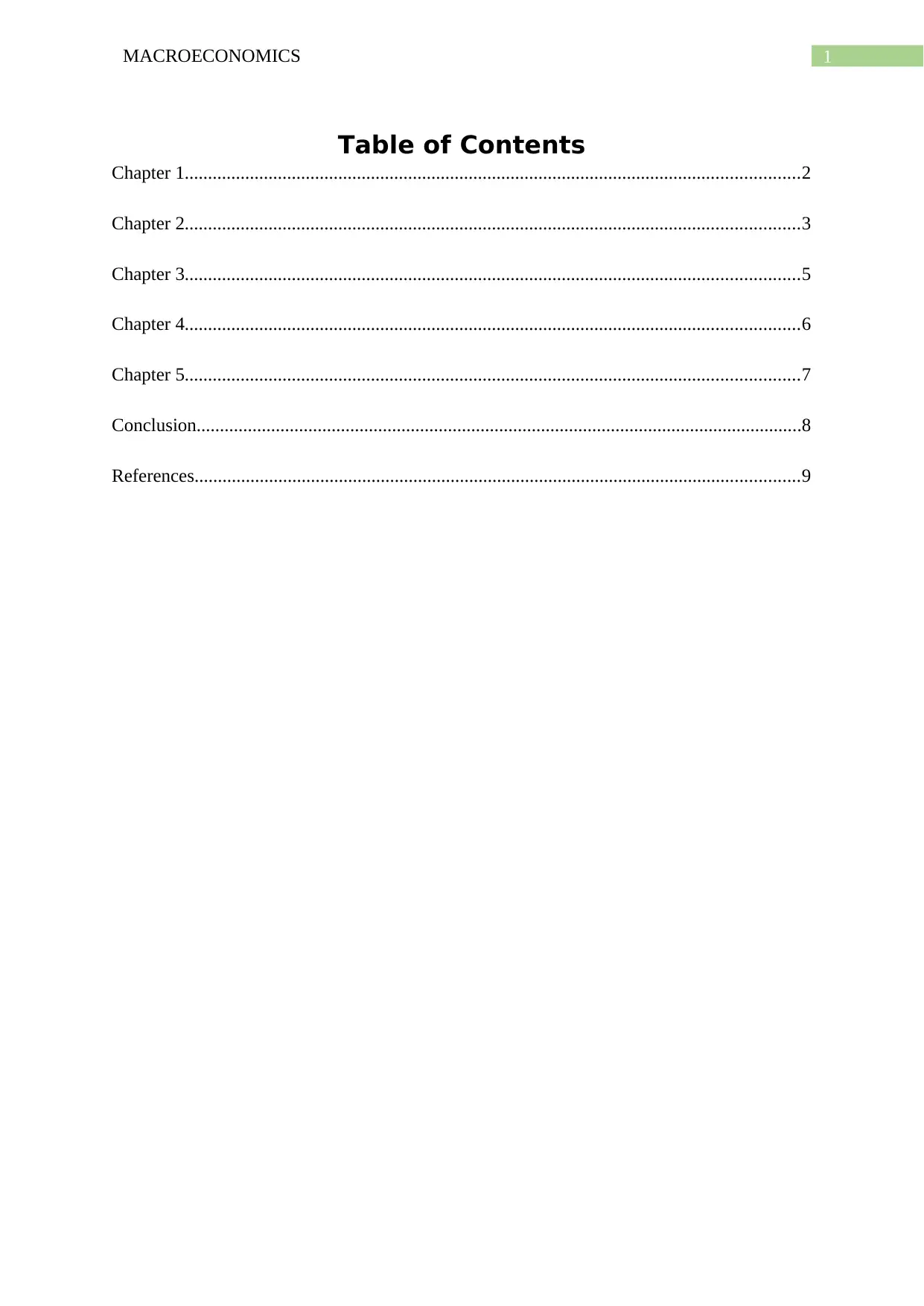
1MACROECONOMICS
Table of Contents
Chapter 1....................................................................................................................................2
Chapter 2....................................................................................................................................3
Chapter 3....................................................................................................................................5
Chapter 4....................................................................................................................................6
Chapter 5....................................................................................................................................7
Conclusion..................................................................................................................................8
References..................................................................................................................................9
Table of Contents
Chapter 1....................................................................................................................................2
Chapter 2....................................................................................................................................3
Chapter 3....................................................................................................................................5
Chapter 4....................................................................................................................................6
Chapter 5....................................................................................................................................7
Conclusion..................................................................................................................................8
References..................................................................................................................................9
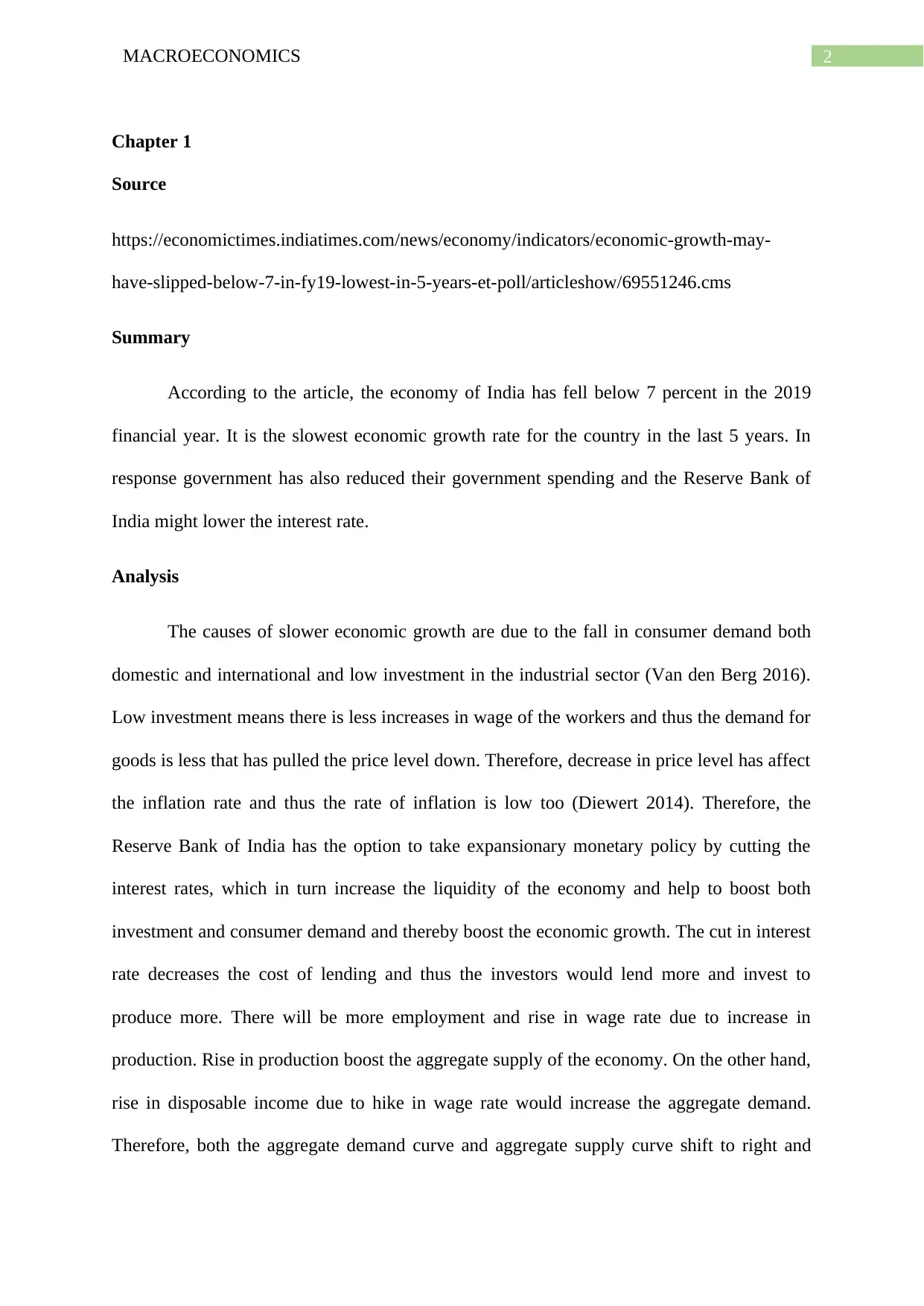
2MACROECONOMICS
Chapter 1
Source
https://economictimes.indiatimes.com/news/economy/indicators/economic-growth-may-
have-slipped-below-7-in-fy19-lowest-in-5-years-et-poll/articleshow/69551246.cms
Summary
According to the article, the economy of India has fell below 7 percent in the 2019
financial year. It is the slowest economic growth rate for the country in the last 5 years. In
response government has also reduced their government spending and the Reserve Bank of
India might lower the interest rate.
Analysis
The causes of slower economic growth are due to the fall in consumer demand both
domestic and international and low investment in the industrial sector (Van den Berg 2016).
Low investment means there is less increases in wage of the workers and thus the demand for
goods is less that has pulled the price level down. Therefore, decrease in price level has affect
the inflation rate and thus the rate of inflation is low too (Diewert 2014). Therefore, the
Reserve Bank of India has the option to take expansionary monetary policy by cutting the
interest rates, which in turn increase the liquidity of the economy and help to boost both
investment and consumer demand and thereby boost the economic growth. The cut in interest
rate decreases the cost of lending and thus the investors would lend more and invest to
produce more. There will be more employment and rise in wage rate due to increase in
production. Rise in production boost the aggregate supply of the economy. On the other hand,
rise in disposable income due to hike in wage rate would increase the aggregate demand.
Therefore, both the aggregate demand curve and aggregate supply curve shift to right and
Chapter 1
Source
https://economictimes.indiatimes.com/news/economy/indicators/economic-growth-may-
have-slipped-below-7-in-fy19-lowest-in-5-years-et-poll/articleshow/69551246.cms
Summary
According to the article, the economy of India has fell below 7 percent in the 2019
financial year. It is the slowest economic growth rate for the country in the last 5 years. In
response government has also reduced their government spending and the Reserve Bank of
India might lower the interest rate.
Analysis
The causes of slower economic growth are due to the fall in consumer demand both
domestic and international and low investment in the industrial sector (Van den Berg 2016).
Low investment means there is less increases in wage of the workers and thus the demand for
goods is less that has pulled the price level down. Therefore, decrease in price level has affect
the inflation rate and thus the rate of inflation is low too (Diewert 2014). Therefore, the
Reserve Bank of India has the option to take expansionary monetary policy by cutting the
interest rates, which in turn increase the liquidity of the economy and help to boost both
investment and consumer demand and thereby boost the economic growth. The cut in interest
rate decreases the cost of lending and thus the investors would lend more and invest to
produce more. There will be more employment and rise in wage rate due to increase in
production. Rise in production boost the aggregate supply of the economy. On the other hand,
rise in disposable income due to hike in wage rate would increase the aggregate demand.
Therefore, both the aggregate demand curve and aggregate supply curve shift to right and
⊘ This is a preview!⊘
Do you want full access?
Subscribe today to unlock all pages.

Trusted by 1+ million students worldwide
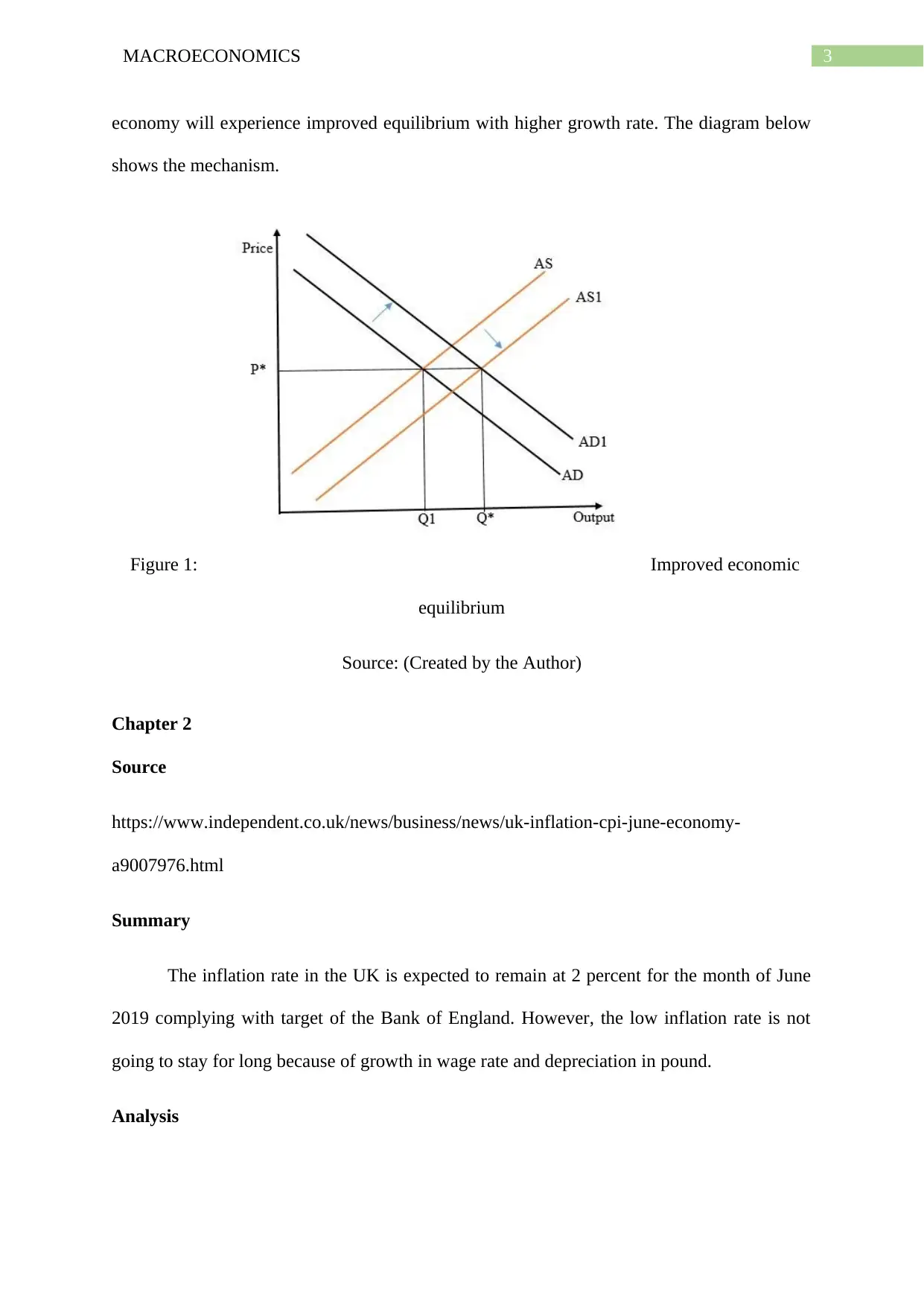
3MACROECONOMICS
economy will experience improved equilibrium with higher growth rate. The diagram below
shows the mechanism.
Figure 1: Improved economic
equilibrium
Source: (Created by the Author)
Chapter 2
Source
https://www.independent.co.uk/news/business/news/uk-inflation-cpi-june-economy-
a9007976.html
Summary
The inflation rate in the UK is expected to remain at 2 percent for the month of June
2019 complying with target of the Bank of England. However, the low inflation rate is not
going to stay for long because of growth in wage rate and depreciation in pound.
Analysis
economy will experience improved equilibrium with higher growth rate. The diagram below
shows the mechanism.
Figure 1: Improved economic
equilibrium
Source: (Created by the Author)
Chapter 2
Source
https://www.independent.co.uk/news/business/news/uk-inflation-cpi-june-economy-
a9007976.html
Summary
The inflation rate in the UK is expected to remain at 2 percent for the month of June
2019 complying with target of the Bank of England. However, the low inflation rate is not
going to stay for long because of growth in wage rate and depreciation in pound.
Analysis
Paraphrase This Document
Need a fresh take? Get an instant paraphrase of this document with our AI Paraphraser
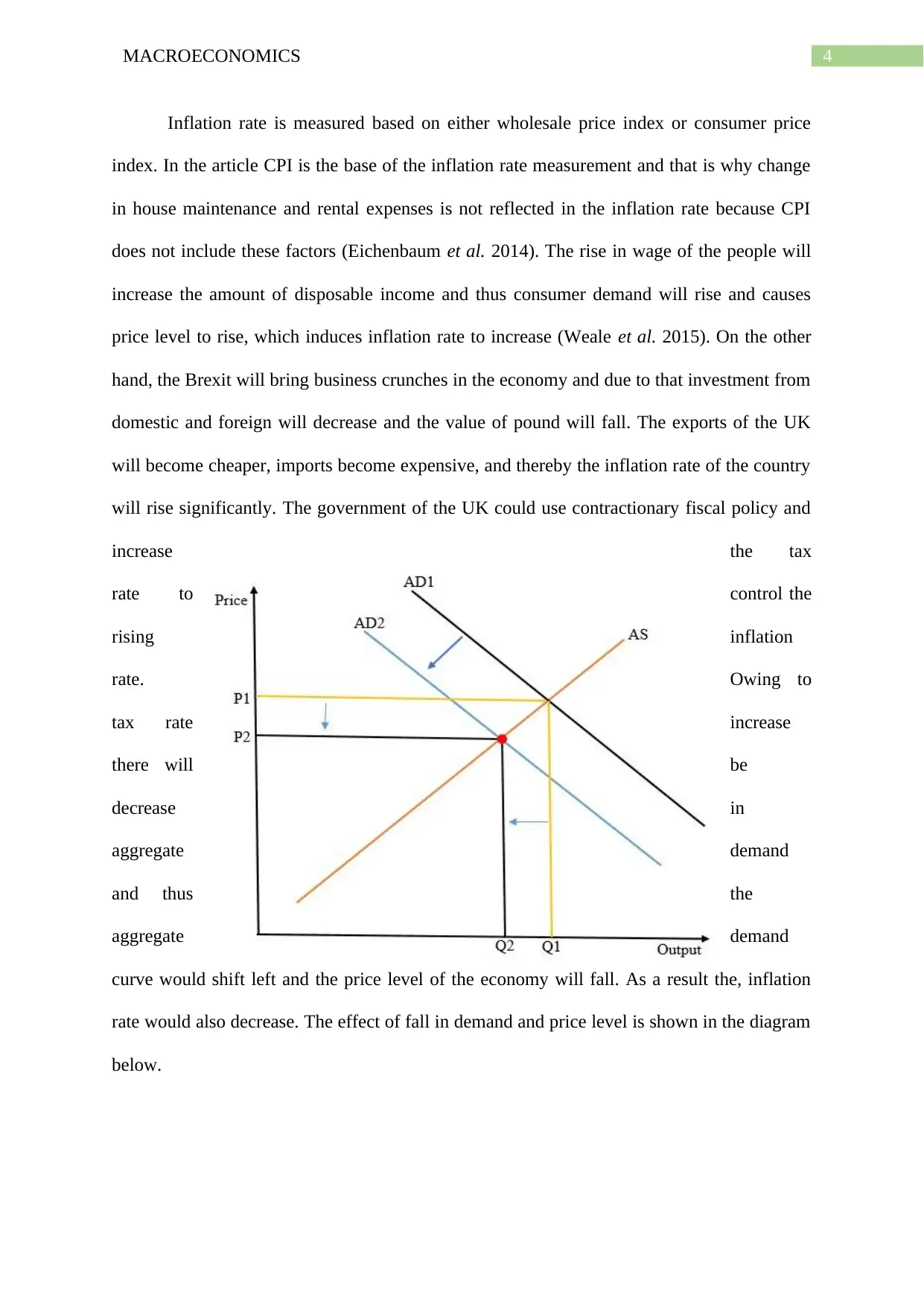
4MACROECONOMICS
Inflation rate is measured based on either wholesale price index or consumer price
index. In the article CPI is the base of the inflation rate measurement and that is why change
in house maintenance and rental expenses is not reflected in the inflation rate because CPI
does not include these factors (Eichenbaum et al. 2014). The rise in wage of the people will
increase the amount of disposable income and thus consumer demand will rise and causes
price level to rise, which induces inflation rate to increase (Weale et al. 2015). On the other
hand, the Brexit will bring business crunches in the economy and due to that investment from
domestic and foreign will decrease and the value of pound will fall. The exports of the UK
will become cheaper, imports become expensive, and thereby the inflation rate of the country
will rise significantly. The government of the UK could use contractionary fiscal policy and
increase the tax
rate to control the
rising inflation
rate. Owing to
tax rate increase
there will be
decrease in
aggregate demand
and thus the
aggregate demand
curve would shift left and the price level of the economy will fall. As a result the, inflation
rate would also decrease. The effect of fall in demand and price level is shown in the diagram
below.
Inflation rate is measured based on either wholesale price index or consumer price
index. In the article CPI is the base of the inflation rate measurement and that is why change
in house maintenance and rental expenses is not reflected in the inflation rate because CPI
does not include these factors (Eichenbaum et al. 2014). The rise in wage of the people will
increase the amount of disposable income and thus consumer demand will rise and causes
price level to rise, which induces inflation rate to increase (Weale et al. 2015). On the other
hand, the Brexit will bring business crunches in the economy and due to that investment from
domestic and foreign will decrease and the value of pound will fall. The exports of the UK
will become cheaper, imports become expensive, and thereby the inflation rate of the country
will rise significantly. The government of the UK could use contractionary fiscal policy and
increase the tax
rate to control the
rising inflation
rate. Owing to
tax rate increase
there will be
decrease in
aggregate demand
and thus the
aggregate demand
curve would shift left and the price level of the economy will fall. As a result the, inflation
rate would also decrease. The effect of fall in demand and price level is shown in the diagram
below.
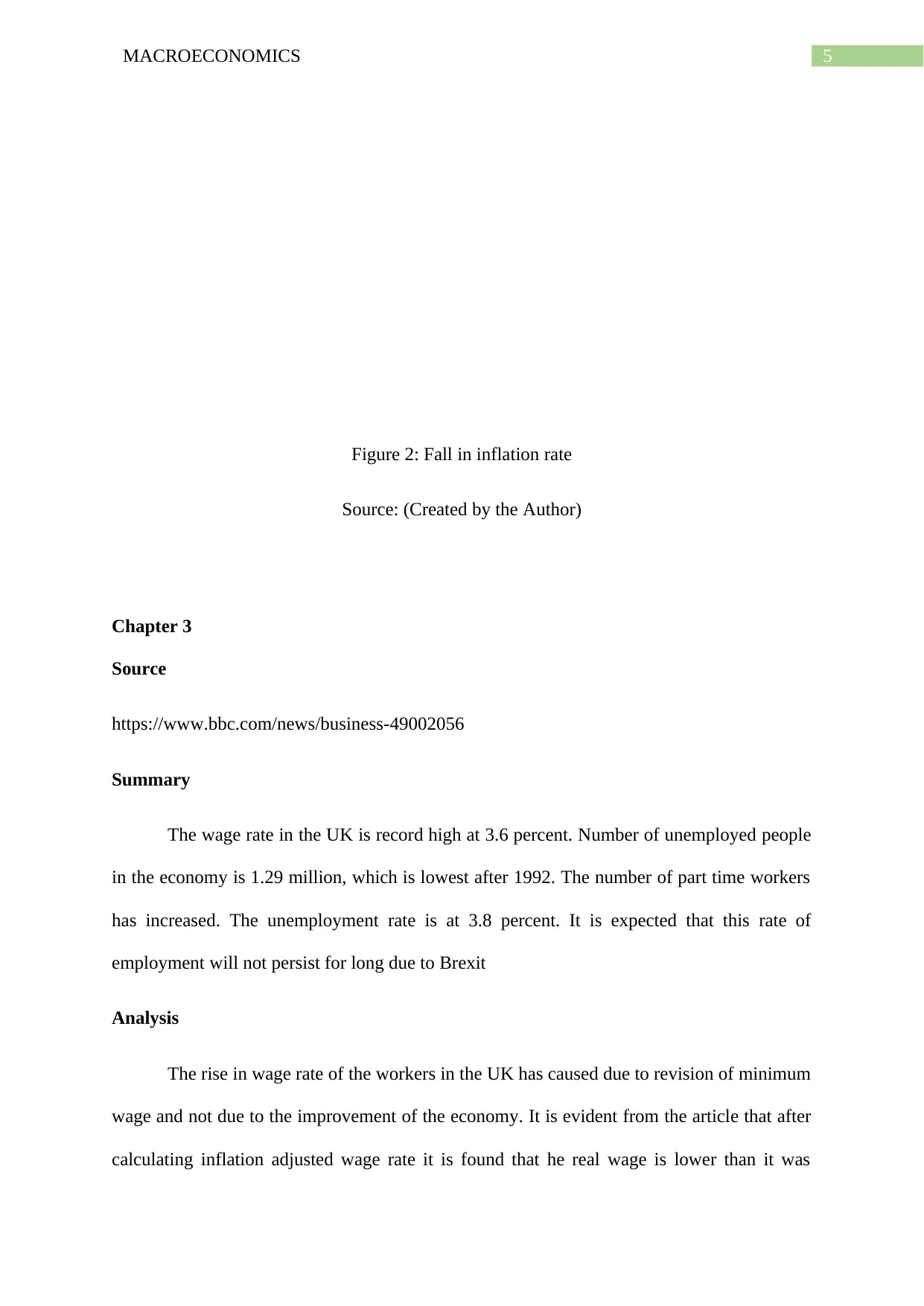
5MACROECONOMICS
Figure 2: Fall in inflation rate
Source: (Created by the Author)
Chapter 3
Source
https://www.bbc.com/news/business-49002056
Summary
The wage rate in the UK is record high at 3.6 percent. Number of unemployed people
in the economy is 1.29 million, which is lowest after 1992. The number of part time workers
has increased. The unemployment rate is at 3.8 percent. It is expected that this rate of
employment will not persist for long due to Brexit
Analysis
The rise in wage rate of the workers in the UK has caused due to revision of minimum
wage and not due to the improvement of the economy. It is evident from the article that after
calculating inflation adjusted wage rate it is found that he real wage is lower than it was
Figure 2: Fall in inflation rate
Source: (Created by the Author)
Chapter 3
Source
https://www.bbc.com/news/business-49002056
Summary
The wage rate in the UK is record high at 3.6 percent. Number of unemployed people
in the economy is 1.29 million, which is lowest after 1992. The number of part time workers
has increased. The unemployment rate is at 3.8 percent. It is expected that this rate of
employment will not persist for long due to Brexit
Analysis
The rise in wage rate of the workers in the UK has caused due to revision of minimum
wage and not due to the improvement of the economy. It is evident from the article that after
calculating inflation adjusted wage rate it is found that he real wage is lower than it was
⊘ This is a preview!⊘
Do you want full access?
Subscribe today to unlock all pages.

Trusted by 1+ million students worldwide
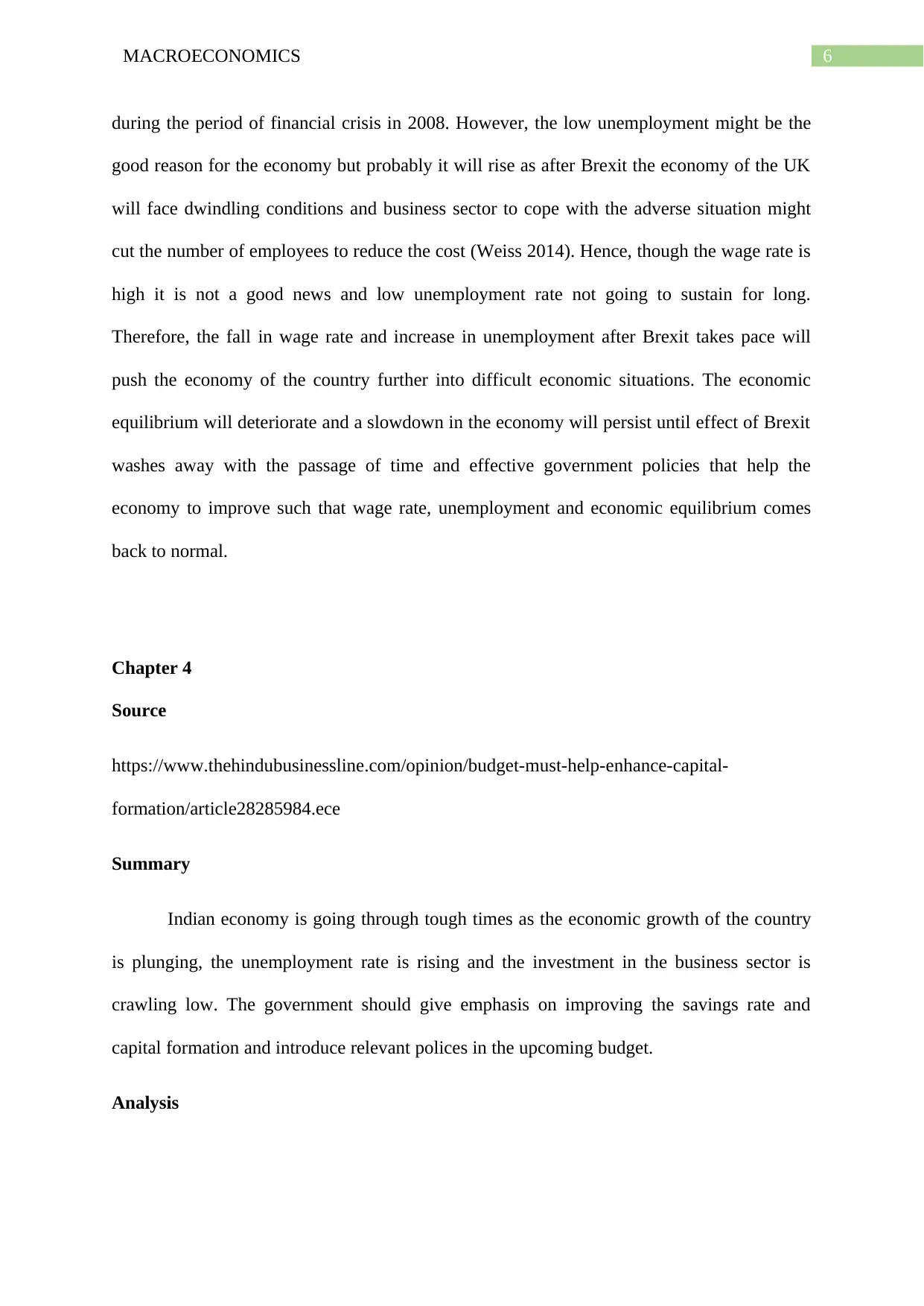
6MACROECONOMICS
during the period of financial crisis in 2008. However, the low unemployment might be the
good reason for the economy but probably it will rise as after Brexit the economy of the UK
will face dwindling conditions and business sector to cope with the adverse situation might
cut the number of employees to reduce the cost (Weiss 2014). Hence, though the wage rate is
high it is not a good news and low unemployment rate not going to sustain for long.
Therefore, the fall in wage rate and increase in unemployment after Brexit takes pace will
push the economy of the country further into difficult economic situations. The economic
equilibrium will deteriorate and a slowdown in the economy will persist until effect of Brexit
washes away with the passage of time and effective government policies that help the
economy to improve such that wage rate, unemployment and economic equilibrium comes
back to normal.
Chapter 4
Source
https://www.thehindubusinessline.com/opinion/budget-must-help-enhance-capital-
formation/article28285984.ece
Summary
Indian economy is going through tough times as the economic growth of the country
is plunging, the unemployment rate is rising and the investment in the business sector is
crawling low. The government should give emphasis on improving the savings rate and
capital formation and introduce relevant polices in the upcoming budget.
Analysis
during the period of financial crisis in 2008. However, the low unemployment might be the
good reason for the economy but probably it will rise as after Brexit the economy of the UK
will face dwindling conditions and business sector to cope with the adverse situation might
cut the number of employees to reduce the cost (Weiss 2014). Hence, though the wage rate is
high it is not a good news and low unemployment rate not going to sustain for long.
Therefore, the fall in wage rate and increase in unemployment after Brexit takes pace will
push the economy of the country further into difficult economic situations. The economic
equilibrium will deteriorate and a slowdown in the economy will persist until effect of Brexit
washes away with the passage of time and effective government policies that help the
economy to improve such that wage rate, unemployment and economic equilibrium comes
back to normal.
Chapter 4
Source
https://www.thehindubusinessline.com/opinion/budget-must-help-enhance-capital-
formation/article28285984.ece
Summary
Indian economy is going through tough times as the economic growth of the country
is plunging, the unemployment rate is rising and the investment in the business sector is
crawling low. The government should give emphasis on improving the savings rate and
capital formation and introduce relevant polices in the upcoming budget.
Analysis
Paraphrase This Document
Need a fresh take? Get an instant paraphrase of this document with our AI Paraphraser
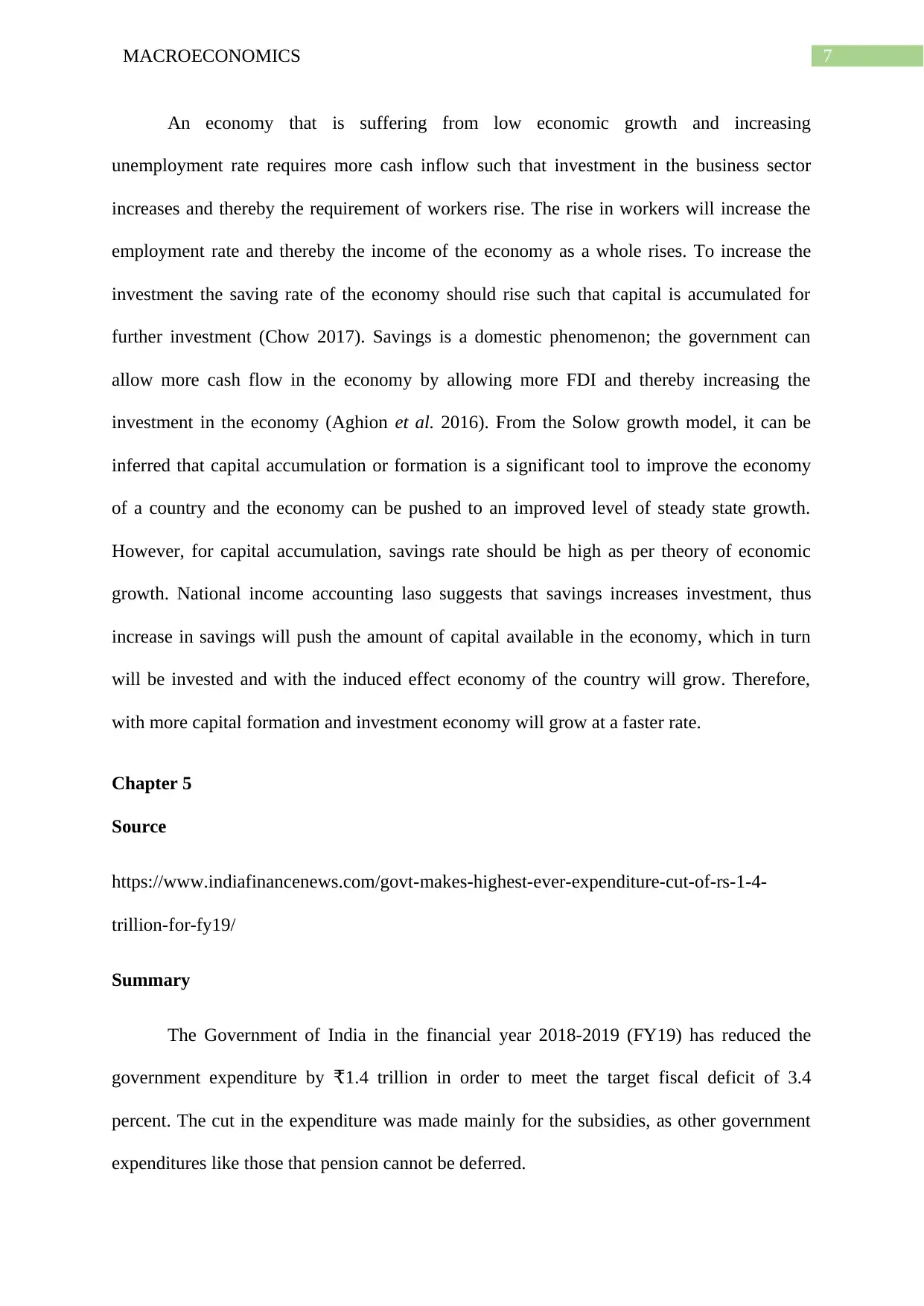
7MACROECONOMICS
An economy that is suffering from low economic growth and increasing
unemployment rate requires more cash inflow such that investment in the business sector
increases and thereby the requirement of workers rise. The rise in workers will increase the
employment rate and thereby the income of the economy as a whole rises. To increase the
investment the saving rate of the economy should rise such that capital is accumulated for
further investment (Chow 2017). Savings is a domestic phenomenon; the government can
allow more cash flow in the economy by allowing more FDI and thereby increasing the
investment in the economy (Aghion et al. 2016). From the Solow growth model, it can be
inferred that capital accumulation or formation is a significant tool to improve the economy
of a country and the economy can be pushed to an improved level of steady state growth.
However, for capital accumulation, savings rate should be high as per theory of economic
growth. National income accounting laso suggests that savings increases investment, thus
increase in savings will push the amount of capital available in the economy, which in turn
will be invested and with the induced effect economy of the country will grow. Therefore,
with more capital formation and investment economy will grow at a faster rate.
Chapter 5
Source
https://www.indiafinancenews.com/govt-makes-highest-ever-expenditure-cut-of-rs-1-4-
trillion-for-fy19/
Summary
The Government of India in the financial year 2018-2019 (FY19) has reduced the
government expenditure by 1.4 trillion in order to meet the target fiscal deficit of 3.4₹
percent. The cut in the expenditure was made mainly for the subsidies, as other government
expenditures like those that pension cannot be deferred.
An economy that is suffering from low economic growth and increasing
unemployment rate requires more cash inflow such that investment in the business sector
increases and thereby the requirement of workers rise. The rise in workers will increase the
employment rate and thereby the income of the economy as a whole rises. To increase the
investment the saving rate of the economy should rise such that capital is accumulated for
further investment (Chow 2017). Savings is a domestic phenomenon; the government can
allow more cash flow in the economy by allowing more FDI and thereby increasing the
investment in the economy (Aghion et al. 2016). From the Solow growth model, it can be
inferred that capital accumulation or formation is a significant tool to improve the economy
of a country and the economy can be pushed to an improved level of steady state growth.
However, for capital accumulation, savings rate should be high as per theory of economic
growth. National income accounting laso suggests that savings increases investment, thus
increase in savings will push the amount of capital available in the economy, which in turn
will be invested and with the induced effect economy of the country will grow. Therefore,
with more capital formation and investment economy will grow at a faster rate.
Chapter 5
Source
https://www.indiafinancenews.com/govt-makes-highest-ever-expenditure-cut-of-rs-1-4-
trillion-for-fy19/
Summary
The Government of India in the financial year 2018-2019 (FY19) has reduced the
government expenditure by 1.4 trillion in order to meet the target fiscal deficit of 3.4₹
percent. The cut in the expenditure was made mainly for the subsidies, as other government
expenditures like those that pension cannot be deferred.
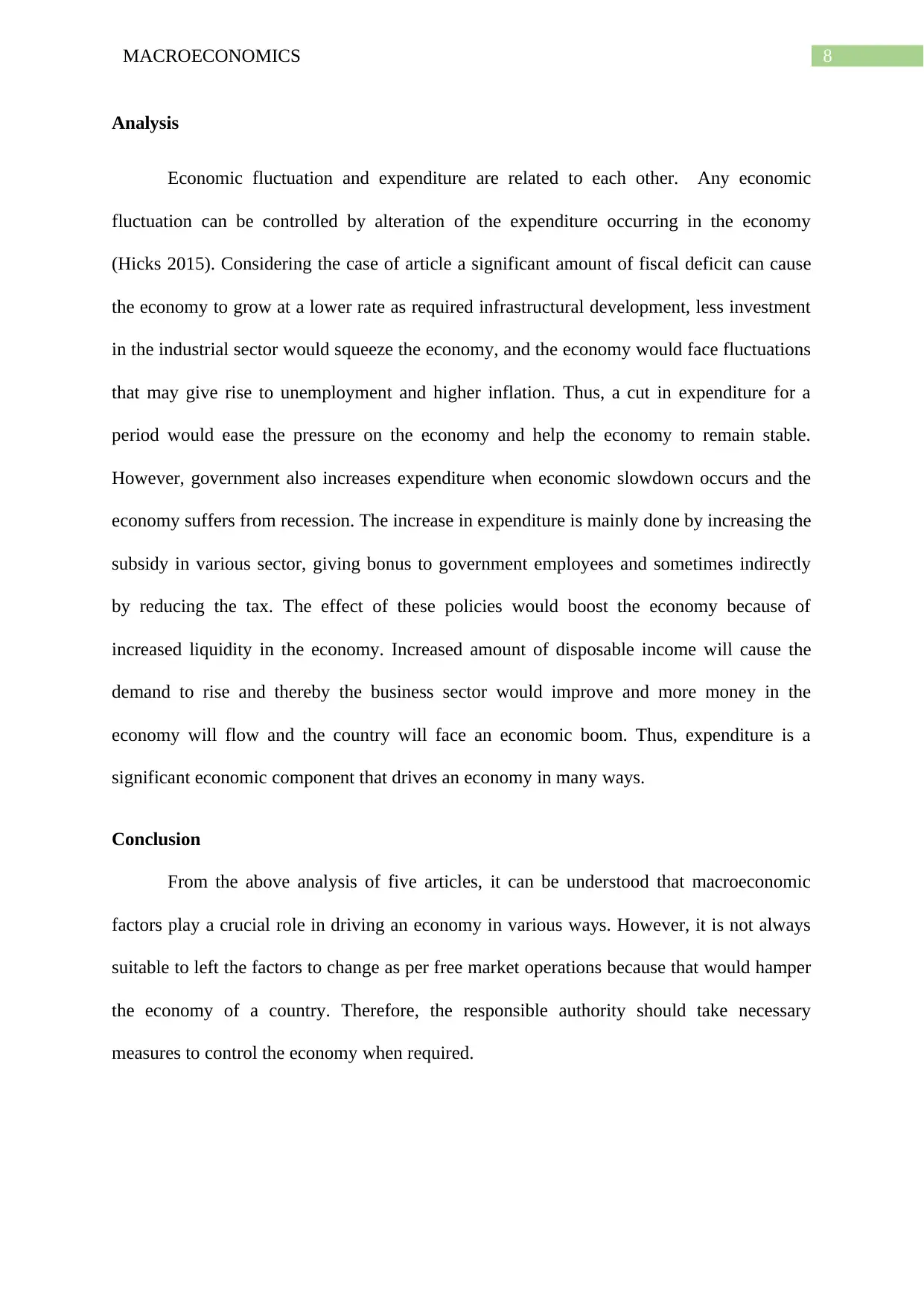
8MACROECONOMICS
Analysis
Economic fluctuation and expenditure are related to each other. Any economic
fluctuation can be controlled by alteration of the expenditure occurring in the economy
(Hicks 2015). Considering the case of article a significant amount of fiscal deficit can cause
the economy to grow at a lower rate as required infrastructural development, less investment
in the industrial sector would squeeze the economy, and the economy would face fluctuations
that may give rise to unemployment and higher inflation. Thus, a cut in expenditure for a
period would ease the pressure on the economy and help the economy to remain stable.
However, government also increases expenditure when economic slowdown occurs and the
economy suffers from recession. The increase in expenditure is mainly done by increasing the
subsidy in various sector, giving bonus to government employees and sometimes indirectly
by reducing the tax. The effect of these policies would boost the economy because of
increased liquidity in the economy. Increased amount of disposable income will cause the
demand to rise and thereby the business sector would improve and more money in the
economy will flow and the country will face an economic boom. Thus, expenditure is a
significant economic component that drives an economy in many ways.
Conclusion
From the above analysis of five articles, it can be understood that macroeconomic
factors play a crucial role in driving an economy in various ways. However, it is not always
suitable to left the factors to change as per free market operations because that would hamper
the economy of a country. Therefore, the responsible authority should take necessary
measures to control the economy when required.
Analysis
Economic fluctuation and expenditure are related to each other. Any economic
fluctuation can be controlled by alteration of the expenditure occurring in the economy
(Hicks 2015). Considering the case of article a significant amount of fiscal deficit can cause
the economy to grow at a lower rate as required infrastructural development, less investment
in the industrial sector would squeeze the economy, and the economy would face fluctuations
that may give rise to unemployment and higher inflation. Thus, a cut in expenditure for a
period would ease the pressure on the economy and help the economy to remain stable.
However, government also increases expenditure when economic slowdown occurs and the
economy suffers from recession. The increase in expenditure is mainly done by increasing the
subsidy in various sector, giving bonus to government employees and sometimes indirectly
by reducing the tax. The effect of these policies would boost the economy because of
increased liquidity in the economy. Increased amount of disposable income will cause the
demand to rise and thereby the business sector would improve and more money in the
economy will flow and the country will face an economic boom. Thus, expenditure is a
significant economic component that drives an economy in many ways.
Conclusion
From the above analysis of five articles, it can be understood that macroeconomic
factors play a crucial role in driving an economy in various ways. However, it is not always
suitable to left the factors to change as per free market operations because that would hamper
the economy of a country. Therefore, the responsible authority should take necessary
measures to control the economy when required.
⊘ This is a preview!⊘
Do you want full access?
Subscribe today to unlock all pages.

Trusted by 1+ million students worldwide
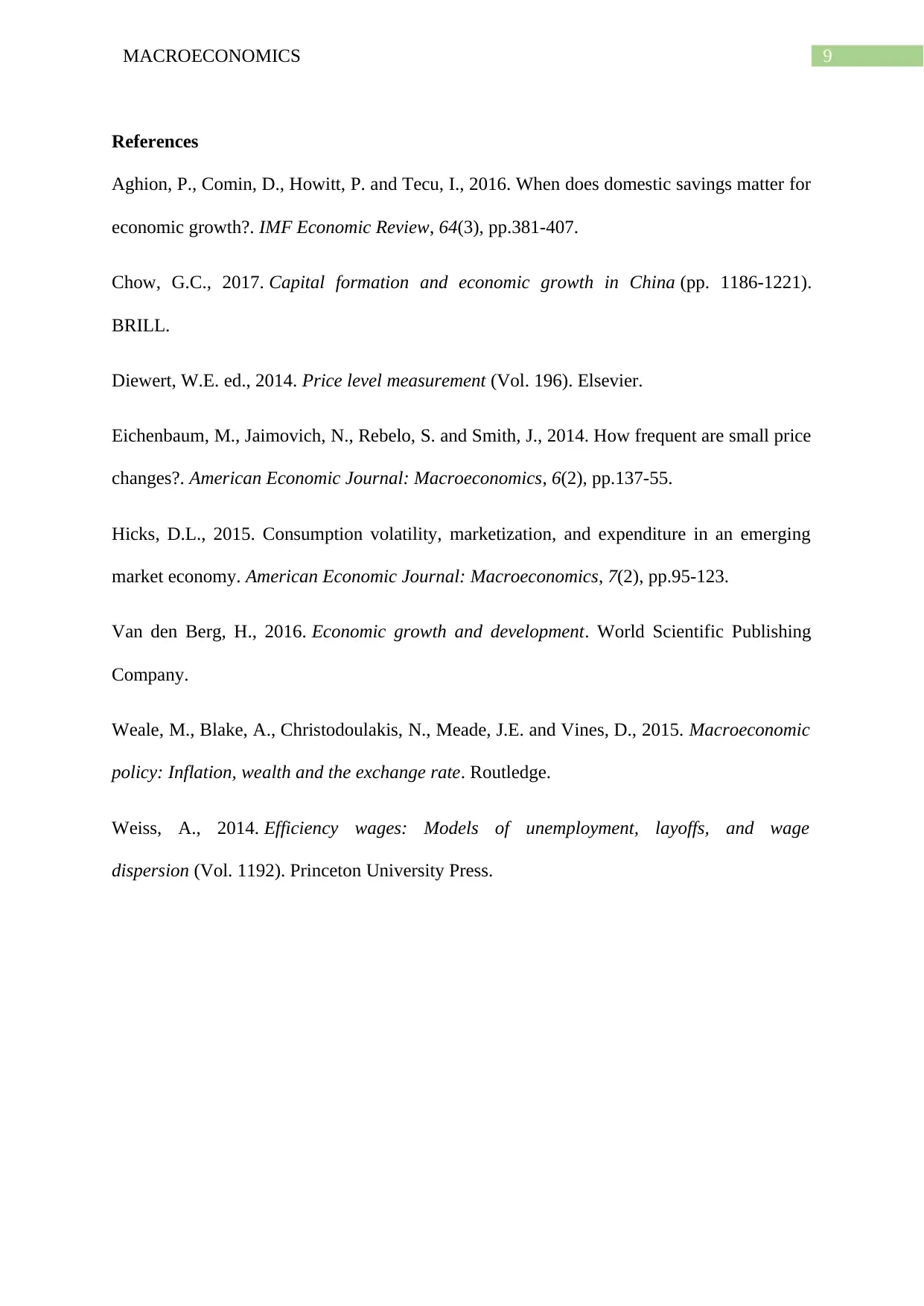
9MACROECONOMICS
References
Aghion, P., Comin, D., Howitt, P. and Tecu, I., 2016. When does domestic savings matter for
economic growth?. IMF Economic Review, 64(3), pp.381-407.
Chow, G.C., 2017. Capital formation and economic growth in China (pp. 1186-1221).
BRILL.
Diewert, W.E. ed., 2014. Price level measurement (Vol. 196). Elsevier.
Eichenbaum, M., Jaimovich, N., Rebelo, S. and Smith, J., 2014. How frequent are small price
changes?. American Economic Journal: Macroeconomics, 6(2), pp.137-55.
Hicks, D.L., 2015. Consumption volatility, marketization, and expenditure in an emerging
market economy. American Economic Journal: Macroeconomics, 7(2), pp.95-123.
Van den Berg, H., 2016. Economic growth and development. World Scientific Publishing
Company.
Weale, M., Blake, A., Christodoulakis, N., Meade, J.E. and Vines, D., 2015. Macroeconomic
policy: Inflation, wealth and the exchange rate. Routledge.
Weiss, A., 2014. Efficiency wages: Models of unemployment, layoffs, and wage
dispersion (Vol. 1192). Princeton University Press.
References
Aghion, P., Comin, D., Howitt, P. and Tecu, I., 2016. When does domestic savings matter for
economic growth?. IMF Economic Review, 64(3), pp.381-407.
Chow, G.C., 2017. Capital formation and economic growth in China (pp. 1186-1221).
BRILL.
Diewert, W.E. ed., 2014. Price level measurement (Vol. 196). Elsevier.
Eichenbaum, M., Jaimovich, N., Rebelo, S. and Smith, J., 2014. How frequent are small price
changes?. American Economic Journal: Macroeconomics, 6(2), pp.137-55.
Hicks, D.L., 2015. Consumption volatility, marketization, and expenditure in an emerging
market economy. American Economic Journal: Macroeconomics, 7(2), pp.95-123.
Van den Berg, H., 2016. Economic growth and development. World Scientific Publishing
Company.
Weale, M., Blake, A., Christodoulakis, N., Meade, J.E. and Vines, D., 2015. Macroeconomic
policy: Inflation, wealth and the exchange rate. Routledge.
Weiss, A., 2014. Efficiency wages: Models of unemployment, layoffs, and wage
dispersion (Vol. 1192). Princeton University Press.
1 out of 10
Related Documents
Your All-in-One AI-Powered Toolkit for Academic Success.
+13062052269
info@desklib.com
Available 24*7 on WhatsApp / Email
![[object Object]](/_next/static/media/star-bottom.7253800d.svg)
Unlock your academic potential
Copyright © 2020–2025 A2Z Services. All Rights Reserved. Developed and managed by ZUCOL.




